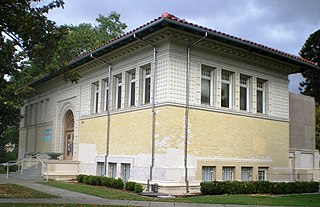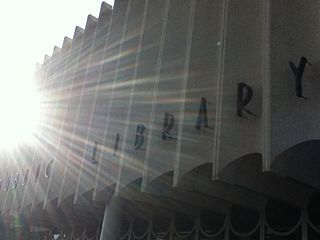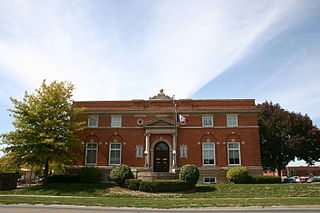
Gratz Park is a neighborhood and historic district located just north of downtown Lexington, Kentucky. It was named after early Lexington businessman Benjamin Gratz whose home stands on the corner of Mill and New streets at the edge of Gratz Park. The Gratz Park Historic District consists of 16 contributing buildings including the Hunt-Morgan House, the Bodley-Bullock House, the original Carnegie Library in Lexington, and several other private residences. Gratz Park occupies a tract of land that was established in 1781 outside the original boundaries of Lexington.

Vermont Square Branch Library is the oldest branch library in the Los Angeles Public Library system. Located about a mile southwest of the University of Southern California campus, in the Vermont Square district, it was built in 1913 with a grant from Andrew Carnegie. One of three surviving Carnegie libraries in Los Angeles, it has been designated a Historic-Cultural Monument and listed on the National Register of Historic Places.

The Carnegie Art Museum is a public art museum owned by the City of Oxnard, California in the building originally occupied by the Oxnard Public Library. The Neo-Classical building, located adjacent to Oxnard's Plaza Park, opened in 1907 as the Oxnard Public Library and was converted into an art museum in 1986. In July 1971, it became the first building in Ventura County and the first Carnegie library in California to be listed on the National Register of Historic Places.

This is a list of the National Register of Historic Places listings in Brule County, South Dakota.

The Greenwich Avenue Historic District is a historic district representing the commercial and civic historical development of the downtown area of the town of Greenwich, Connecticut. The district was listed on the National Register of Historic Places on August 31, 1989. Included in the district is the Greenwich Municipal Center Historic District, which was listed on the National Register the year before for the classical revival style municipal buildings in the core of Downtown. Most of the commercial buildings in the district fall into three broad styles, reflecting the period in which they were built: Italianate, Georgian Revival, and Commercial style. The district is linear and runs north–south along the entire length of Greenwich Avenue, the main thoroughfare of Downtown Greenwich, between U.S. Route 1 and the New Haven Line railroad tracks.

The Springfield Public School located in the Strip District neighborhood of Pittsburgh, Pennsylvania, was built in 1872 and closed in 1934. After closing it served as a warehouse. The building was listed on the National Register of Historic Places in 1986.

North Dakota State University District is a 36-acre (15 ha) historic district on the campus of North Dakota State University, in Fargo, North Dakota, that was listed on the National Register of Historic Places in 1986.

The Public Library of Enid and Garfield County, is a public library located in Enid, Oklahoma, the county seat of Garfield County, Oklahoma.

The Exeter Public Library is a Carnegie library located at 309 S. E St. in Exeter, California. The library was built in 1916 with a $5000 grant from the Carnegie Foundation; it was one of six Carnegie libraries built in Tulare County. Exeter's library program had been started in 1910 by the city Women's Club but lacked its own building prior to the construction of the Carnegie Library. The library was designed in the Mission Revival style by A. Merrill Bowser, whose plans were selected from three designs submitted to James Bertram. The design includes a low hip roof, a gabled parapet, and a wide entrance with panels of glass to the sides of the door. A Union Jack motif is used in the windows and the transom above the front door. The building served as the city's library until 1976, when it became a community center. It is one of two surviving Carnegie libraries in Tulare County, the other being the Orosi Branch Library.

Mystic is a ghost town in Pennington County, in the U.S. state of South Dakota. It began as a placer mining encampment called Sitting Bull in 1876, later attracting multiple railroads to the area. Its population began to decline in the early 20th century, and it now has few to no permanent residents. The old townsite was added to the National Register of Historic Places in 1986 under the name Mystic Townsite Historic District.

Oskaloosa Public Library is a facility located in Oskaloosa, Iowa, United States. Construction of the library was launched in 1902 with a grant from the Carnegie Corporation of New York. The building was added to the National Register of Historic Places in 1991.

The Delaware Public Library is a former public library in Delaware, Ohio. The building was funded by Andrew Carnegie and built in the neoclassical style. It opened to the public in 1906. The library's collection of books and volumes rapidly expanded during its operational history. By the 1970s, the Delaware Public Library started to run out of space. In 1984, a new public library was constructed, and Delaware County, Ohio started using the Delaware Public Library for office space. The building was tripled in size during a construction and restoration project that lasted from 1999 to 2001. The Delaware Public Library is currently used to house a number of Delaware County agencies, including the Delaware County Board of Commissioners.

The College View Public Library is a historic building in the College View neighborhood of Lincoln, Nebraska, United States. It was built in 1916 as a Carnegie library with a $7,500 grant from the Carnegie Corporation. The design is Classical Revival, with "a symmetrical front facade, simple brick corner pilasters, a water table and wall cornice, and a pedimented entrance enframed by Roman Ionic columns in antis". It has been listed on the National Register of Historic Places since June 28, 1984.

Rapid City Fruit Company is a historic commercial building at 320 7th Street in Rapid City, South Dakota. It was built in 1920 and was the first refrigerated warehouse in the city. It was listed on the National Register of Historic Places in 1993.

The Security Bank Building, also known as the Security Building, is a historic commercial building at 101 South Main Avenue in downtown Sioux Falls, South Dakota. It was the first steel-framed office building to be built in the state. It was added to the National Register of Historic Places in 1984 for its architectural design and integrity, as well as for being the site of a bank robbery by the Dillinger Gang in 1934.

Rapid City High School (RCHS), formerly the Dakota Junior High School and then the Dakota Middle School, is an alternative high school at 601 Columbus Street, Rapid City, South Dakota. Established in 1923, the building served as the first site of Rapid City Central High School until it moved to a new facility on Mount Rushmore Road North. Rapid City High School also hosts the Performing Arts Center of Rapid City. The school building was listed on the National Register of Historic Places on June 28, 2010.

The Lake Andes Carnegie Library, in Lake Andes, South Dakota in Charles Mix County, South Dakota, is a Carnegie library which was built in 1911. It was listed on the National Register of Historic Places in 2000.

The Rapid City Historic Commercial District, sometimes called the Rapid City Downtown Historic District, is a 21-acre (8.5 ha), multi-block historic district in downtown Rapid City, South Dakota, United States. It includes 47 commercial buildings dating from the late 19th to early 20th centuries that formed the core of Rapid City's early economy. It was first listed on the National Register of Historic Places in 1974 and then expanded to its current size in 1998.





















